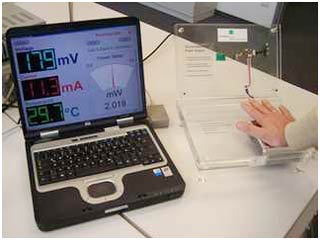Generate electricity from the body's heat
Call from a mobile phone without a battery, just use the warmth of your hand? That is no longer a vague dream. New circuits can completely take the body's heat to produce electricity.
There are many medical devices attached to the patient's body located in the intensive care unit. These devices check heart rate, blood pressure, body temperature, pulse and breathing. This often creates a wire mess because all these devices need to be powered. In the future, medical sensors will be able to operate without electricity from a wall outlet. Instead, they will collect all the energy they need from the warmth of the human body.
Scientists at the Fraunhofe Institute have developed a way to capture natural heat in the body to produce electricity that operates on the principle of thermoelectric generators or, in short , TEG , made from semiconductor elements. . TEG takes electrical energy from the heat difference between a hot environment and a cold environment.

New circuits transform the body's heat - like the heat of the hand - into electricity.(Photo: Fraunhofer IIS)
Normally, a difference of several tens of degrees is needed to produce enough energy, but the difference between the body surface temperature and the environment temperature is only a few degrees.
'Only low voltages can be produced from such differences,' said Peter Spies, project director. A normal TEG machine will generate a voltage of about 200 millivolts, but electronic devices need at least one or two volts.
Engineers have found a solution to this problem: 'We combine many components in a completely new way to create circuits capable of operating at 200 millivolts,' said Spies. 'This helps us to create an entire electronic system that doesn't need an internal battery, but only gets energy from the body's temperature.'
Scientists are improving the system even more: there are circuits that operate at 50 millivolts.
Peter Pies believes that in the future when significant improvements are made to switching systems, just a temperature difference of 0.5 degrees will be enough to generate electricity.
Scientists have focused on different applications: 'It is possible to generate electricity from heat wherever a temperature difference occurs,' said Spies. 'It can be on the body, on the radiator to measure the heat loss when monitoring the cooling chain during transport of chilled goods or in air conditioning systems.'
Thanh Van
- Use volcanoes to produce electricity
- Phone can take electricity from human body
- Utilizing exhaust gas from cars to generate electricity
- The team of scientists who make 'reverse solar cells', in the dark, also generates electricity
- Generate electricity from garbage
- Shorts and sleeping bags can generate electricity
- Carbon nanotube can generate large currents
- Use beer residue to generate electricity
- Hybridisation of electricity and light
- Turn urine into electricity
- Strange 5 animals capable of generating electricity
- New method to convert heat into electricity.
 Daily use inventions come from universities
Daily use inventions come from universities Special weight loss device helps prevent appetite
Special weight loss device helps prevent appetite 8 inventors were killed by their own inventions
8 inventors were killed by their own inventions Iran invented a motor car powered by water
Iran invented a motor car powered by water